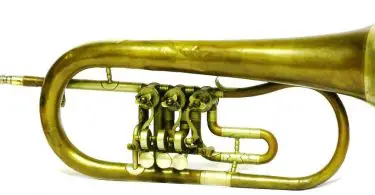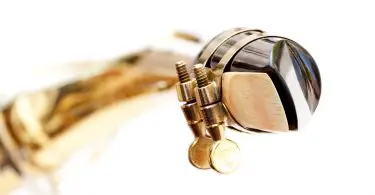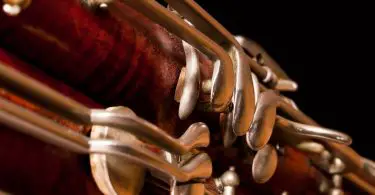Woodwinds, as with any instrument, need proper maintenance to not only sustain a great sound but also keep up that shining appearance. You should handle your woodwind with the utmost care, and also remember to practice good cleaning techniques.
There are various cleaning and care accessories for woodwind instruments that work across the board from clarinets to saxophones.
Regardless of which member of the woodwind family you play, you can preserve quality sound for years to come with the right products.
The following guide will reveal what we believe to be some of the best accessories to do just that.
-
 Check on Musician's Friend Check on Amazon
Check on Musician's Friend Check on AmazonDesigned specifically to allow the mouthpiece to fit easier.
-
 $17.49Check on Amazon
$17.49Check on AmazonCrafted from a non-scratch, lightweight wood, and manages to combine characteristics from both metal-based and plastic-based rods.
06/28/2025 11:21 pm GMT -
-
-
-
-
The Best Cleaning & Care Accessories
Cork Grease
Cork grease is a lubricant-like substance used for both woodwind and reed instruments. It allows you to assemble an instrument without causing damage to it and the cork.
This grease preserves the cork, sealing it so that no air leaks through during play.
Top Pick: Vandoren
Designed specifically to allow the mouthpiece to fit easier.
In general: cork grease is cork grease. However, some still stand out above the others. The Vandoren Cork Grease (Tube) is high-quality cork grease, and it comes in a lipstick-like tube for easier use.

Credit: Guitar Center, Inc
It is even scented with an apple blossom fragrance. The grease may seem harder than other brands, but this hardness can help limit excessive application of the product.
You can purchase a single tube at Musician’s Friend for just under $3.
Mouthpiece Brushes
Mouthpiece brushes keep your mouthpiece free of grime or dirt, which is essential for proper playing. Clean mouthpieces prevent air flow from being obstructed.
Using a brush designed specifically for it allows it to fit the mouthpiece easier, and it can also prevent any unnecessary complications that can come from using something else like a toothbrush.
Top Pick: Venture Woodwind
Help keep your instrument free of moisture, a fight that all woodwind players have to endure after each playing session.
The Venture Woodwind Mouthpiece Brush is a go-to choice for many woodwind players. It is slim and designed to fit inside any woodwind mouthpiece.
What is even better about this accessory is that it doesn’t cost much to get.

Credit: Amazon.com
Pad-Savers help keep your instrument free of moisture, a fight that all woodwind players have to endure after each playing session.
In short, pad-savers are pipe cleaners made to fit inside the bore of your instrument to clean and drive away any lingering moisture.
It also helps keep dust from staying on the pads and extends the life of the pads. Know that to clean pad-savers, it is recommended that they be hand-washed.
When you buy pad-savers, you may be told that one can be stored inside your instrument. Be aware that this can allow moisture that the pad-saver absorbed to remain close to the pads.
This can cause damage to the pads over time, so it may be in your best interest to not store a pad-saver inside an instrument.
Top Pad-Saver: H.W. Alto Sax
Many pad-savers are designed to fit specific instruments. As one of the best, we chose the H.W. Alto Sax Pad-Saver made for use in an alto saxophone.
Made using microfiber material intended to hold up against any bleeding, shrinking, or shredding.

Credit: Dawkes Music Ltd
It is made using microfiber material intended to hold up against any bleeding, shrinking, or shredding.
Top Cleaning Rod: Yamaha Wooden Flute
Crafted from a non-scratch, lightweight wood, and manages to combine characteristics from both metal-based and plastic-based rods.
Cleaning rods typically come with flutes. If you did not get one with your flute, then we recommend trying the Yamaha Wooden Flute Cleaning Rod.

Credit: Amazon.com
It is crafted from a non-scratch, lightweight wood, and manages to combine characteristics from both metal-based and plastic-based rods.
It will not scratch up your instrument, much like with plastic rods, and it’s also durable and rigid, as with metal rods. You are experiencing the best of both worlds here.
Additional Cleaning & Care Products to Consider
To provide you with more possible items that can make maintaining your woodwind a simpler task, we looked at several additional accessories. Some serve as supplements to the products listed above.
Rico Premium Woodwind Cork Grease
As we mentioned before, cork grease is cork grease. Most wind up being the same, but some do have various properties that can give them a bit of an edge.
The first quality that stands out about the Rico Premium is that it is as inexpensive as the Vandoren brand. Amazon sells a single tube and a pack of 12.
The Rico Premium comes in a lip balm-like tube also, and it absorbs well without leaving build up behind. The Rico brand is also firmer than some other cork greases, but it may come across as too hard to use sometimes.
Hagerty Silver Polish
The above strips may be able to keep an instrument tarnish-free, but in the event that tarnish does occur, a polish such as the Hagerty one can come in handy.
It is gentle and safe, which may require some more work using than other polishes, but the end results can make the effort and time worth it.
It both polishes and cleans sterling, silver-plated, and gold pieces. Also, it even works with non-rinse and porous items such as wood and cork.
To keep tarnish from returning for months on end, Hagerty has utilized its infamous R-22 tarnish preventive ingredient inside their polish.
Selmer Dri Bore Clarinet Swab
We will reiterate here and mention how moisture readily builds-up in woodwind instruments. You are always going to get saliva in numerous places like the bore of the instrument.
A swab can soak up all that moisture. The Selmer Dri Bore Swab is ultra absorbent (although sometimes it may not suck up all of the moisture), and it pulls right on through.
The weighted end of it makes it just the right amount of heavy to drop through the instrument without you having to force it or shake your woodwind.
As long as the string isn’t knotted or tangled, it doesn’t catch on the way down either. It’s rather affordable as well. Over at Musician’s Friend, it’s priced at around $3.
Yamaha Bore Oil
This bore oil from Yamaha uses premium ingredients to allow the oil to soak right into the wood of your instrument. It’s versatile as it can be used not just for woodwind instruments, but on guitars as well.
For woodwind instruments, the oil is easy to apply, and it absorbs readily, adding a protective layer against moisture while making sure the instrument sounds as good as new.
It is also odorless as well, so you won’t be distracted or put-off by any strange scents. The Yamaha Bore Oil sells for around $8 at Musician’s Friend.
Care Kits
If you are looking to buy most of your accessories all at once, then perhaps consider the various care kits on the market.
Generally, they contain the basics you will need to adequately maintain your instrument: polishing cloth, mouthpiece brush, cotton brush swab, cork grease, bore oil, etc.
They are not usually expensive, and can make an optimal package for a student player just getting into maintaining their instrument.
Over at Musician’s Friend, you can find the Giardinelli Clarinet Maintenance and Care Kit.
There are kits aimed specifically for the variety of woodwind instruments. Search for the one that will best suit your needs.
Maintaining Your Woodwind Instrument
We’ll review the basics for caring and cleaning your woodwind to keep the instrument in prime playing condition.
Secure Your Instrument
Although there are several small accessories you can buy to care for your instrument, be sure not to forget the simplest products: cases and gig bags. Accidents can, unfortunately, happen.
While a case or bag may not protect from everything, they can certainly help lessen any damage from falls or bumps.
As they are designed to securely hold the instrument, it is best not to place anything else inside the case with it such as an abundance of sheet music or other accessories like reeds.
Anything loose can move around and cause unnecessary and avoidable damage to the instrument.
Before you ever move an instrument that is in a case or bag, check it out to make sure everything is secured.
All latches and hinges should be fastened to prevent any accidental drops that can occur from picking up a case that isn’t closed.
Store Accessories Properly
There are plenty of accessories that go along with playing a woodwind instrument. As mentioned in the previous section, it is not a wise move to store any of them, no matter how small, inside of a case or bag.
To prevent this, a lot of bags and cases are designed with a separate section designed specifically for accessories. Those types can be a great choice for those that want to have accessories on-hand.
There are also cases made just for accessories. You can easily (and cheaply) buy items like reed cases which are made small enough to fit in a shirt or pants pocket.
Learn Proper Assembly and Disassembly of Your Instrument
Maintaining your woodwind has much to do with putting it together and also taking it apart the right way. You should never have to force any part in its place, or use excessive pressure when disassembling it.
If you ever find yourself struggling, don’t hesitate to ask an instructor for help. You can even take the instrument into a repair shop for further assistance.
Any number of things could be wrong that may be preventing the instrument from coming together or being taken apart. It never hurts to have a professional look at it.
Have the Instrument Professionally Serviced
There are plenty of things you can do right at home to care for and clean your woodwind instrument. However, some things will inevitably require a professional touch.
We recommend that you take your instrument to a repair technician once or twice a year for routine maintenance and thorough cleaning.
They are also useful for discovering things that you may have accidentally overlooked. They can notice problems that may lead to more costly repairs in the future if they are not handled right away.
And if there already has been any damage to the instrument, then you may be best taking it in to be professionally serviced rather than repair it yourself.
At-home repairs done by those with limited experience can often worsen the damage already done.
A professional can detect and fix other issues if your instrument isn’t playing correctly. This can involve a variety of parts such as pads that are too sticky.
There is an informative YouTube video that explains woodwind maintenance, what you can do at home, and when you should take it in for professional services:
Additional Tips
Clean your instrument.
It is important that your instrument is cleaned on a regular basis. Fingerprints and any other residue should be removed with the appropriate cleaning products.
Specific accessories will be expanded on later in the article. For a thorough cleaning of any instrument, it is best to disassemble it and work from there.
Never place anything on top.
It is a given that items placed on an instrument can cause harm to it. Even if an instrument is in a hard case or a bag, potential damage can still happen.
Be aware of temperature/humidity.
Climate can be quite a factor when it comes to any instrument. Anything extreme can wind up harming it.
To prevent this, try not to leave your instrument, case or not, inside an area where extreme temperatures can occur such as in the trunk of your car on a hot or cold day.
Always ensure that your instrument is dry.
Moisture build-up is to be expected when it comes to woodwinds. Even so, it is best to remove this moisture as any inside can cause damage such as corrosion.
Moisture on the outside of an instrument should be wiped off promptly as well to prevent additional damage from the likes of mold.
Take care of what you eat or drink prior to playing.
There can already be an issue when it comes to moisture building up. Another complication arises when a substance like sugar mixes in with saliva.
When that happens, the pads can stick, rendering it difficult to play. This occurs after drinking any sugary beverages like a soft drink, or even if you are chewing gum right before playing.
Try to keep your mouth free from anything that can lead to any complications.
Recap
Designed specifically to allow the mouthpiece to fit easier.
Crafted from a non-scratch, lightweight wood, and manages to combine characteristics from both metal-based and plastic-based rods.
















Hi,
Any tips on dealing with discolouration on a saxophone? I think it has been caused by oxidation. Its not to bad yet, but I’d rather deal with it now than have it get worse and spread.
Thanks!